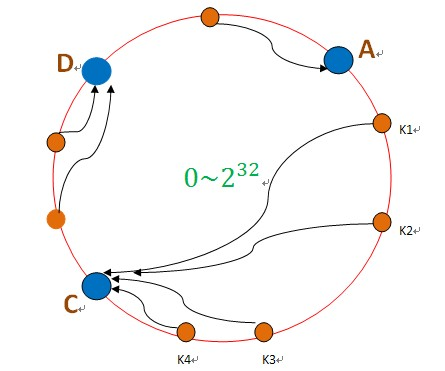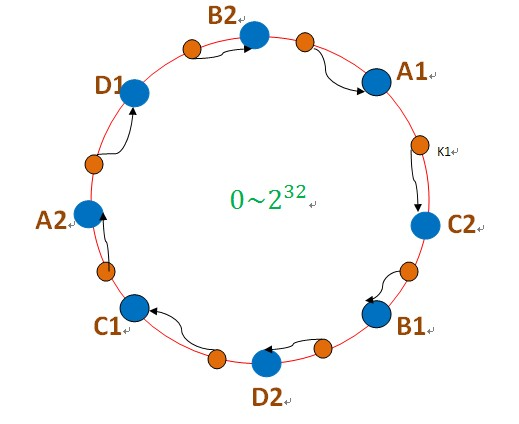一致性哈希算法
使用场景
现在我们假设有100台redis data服务器,一份数据101进来的时候,以散列公式hash(i)&100,计算所存放的服务器,假设hash(i) = i,那么数据被散列到标号为1的服务器,然后这个时候服务器新增了一台,然后散列公式为hash(i)%101,这个时候请求访问数据101的时候,被分配至0号服务器,但是其实这个时候数据是在1号服务器的。
所以这个时候大量的数据失效了(访问不到了)。
所以这个时候,我们假设是新增了服务器,如果是持久化存储的,我们可以让服务器集群对数据进行重新散列,进行数据迁移,然后进行恢复,但是这个时候就意味着每次增减服务器的时候,集群就需要大量的通信,进行数据迁移,这个开销是非常大的。如果只是缓存,那么缓存就都失效了。所以这个时候怎么办?
我们可以看到,关键问题在于,服务器数量变动的时候,要能够保证旧的数据能够按照老的算法,计算到数据所在的服务器,而新的数据能够按照新的散列算法,计算出数据所在的服务器。

如上图,我们有ABCD四台服务器,这四台服务器被分配至0~232 的一个环上,比如0~230的存储在A服务器,230 +1~231 存储到B服务器上.....CD按照这样的进行均分。将我们的散列空间也划为0~232 ,然后数据进来后对232 取模,得到一个值K1,我们根据K1在环上所处的位置,得到所分配到的服务器,如图,K1被分配到B服务器。 这个时候,我们有一台服务器B失效了。

我们可以看到,如果是B失效了,那么如果有持久化存储的,需要做数据恢复,将B的数据迁移至C即可,对于原本散列在A和D的数据,不需要做任何改变。 同理,如果我们是新增了服务器,那么只需要对一台服务器的数据迁移一部分至新加的服务器即可。
一致性hash算法,减少了数据映射关系的变动,不会像hash(i)%N那样带来全局的变动
而且这样还有个好处,假设我们使用UID作为散列范围(即上面的232 ),那么假设有部分UID的访问很频繁,而且这部分UID集中在B服务器上,那么就造成了B的负载远远高于其他服务器。这就是热点数据的问题。这个时候我们可以向B所在的UID空间添加服务器,减少B的压力。
其实还有个更好的解决办法:虚拟节点。
上面说的情况是,使用真实的服务器作为节点散列在232 上。 我们假设,只有4台服务器(如上图),然后A上面有热点数据,结果A挂掉了,然后做数据恢复,A的数据迁移至B,然后B需要承受A+B的数据,也承受不住,也挂了。。。。然后继续CD都挂了。这就造成了
雪崩效应。
上面会造成雪崩效应的原因分析:
如果不存在热点数据的时候,每台机器的承受的压力是M/2(假设每台机器的最高负载能力为M),原本是不会有问题的,但是,这个时候A服务器由于有热点数据挂了,然后A的数据迁移至B,导致B所需要承受的压力变为M(还不考虑热点数据访问的压力),所以这个失败B是必挂的,然后C至少需要承受1.5M的压力。。。。然后大家一起挂。。。
所以我们通过上面可以看到,之所以会大家一起挂,原因在于如果一台机器挂了,那么它的压力全部被分配到一台机器上,导致雪崩。
如果我们A挂了以后,数据被平均分配到BCD上,每台机器多承受M/6的压力,然后大家就都不会挂啦(不考虑热点数据)。
这里引入虚拟节点,如图:

环上的空间被划分为8份,然后A存储A1和A2。。。
这个时候,如果A服务器挂了,访问压力会分配至C2和D1,也就是C和D服务器,而不是像前面,全部被分配到B上。
引入虚拟节点,主要在于,如果一台服务器挂了,能够将压力引流至不同的服务器。
总结:一致性hash算法(DHT)通过减少影响范围的方式解决了增减服务器导致的数据散列问题,从而解决了分布式环境下负载均衡问题,如果存在热点数据,那么通过增添节点的方式,对热点区间进行划分,将压力分配至其他服务器。重新达到负载均衡的状态。
tair的负载均衡就是采用的一致性hash算法啦~~~
一致性hash算法在分布式环境中应用的很广,只要是涉及到分布式存储的负载均衡问题,一致性hash都是很好的解决的方案。
hashring安装
下载hashring https://pypi.python.org/pypi/hash_ring#downloads
找到hash_ring.py文件,如果是python2.x环境直接拿来可以用
如果安装环境python3.x,需要在hash_ring.py文件里做如下修改

1 # -*- coding: utf-8 -*- 2 """ 3 hash_ring 4 ~~~~~~~~~~~~~~ 5 Implements consistent hashing that can be used when 6 the number of server nodes can increase or decrease (like in memcached). 7 8 Consistent hashing is a scheme that provides a hash table functionality 9 in a way that the adding or removing of one slot 10 does not significantly change the mapping of keys to slots. 11 12 More information about consistent hashing can be read in these articles: 13 14 "Web Caching with Consistent Hashing": 15 http://www8.org/w8-papers/2a-webserver/caching/paper2.html 16 17 "Consistent hashing and random trees: 18 Distributed caching protocols for relieving hot spots on the World Wide Web (1997)": 19 http://citeseerx.ist.psu.edu/legacymapper?did=38148 20 21 22 Example of usage:: 23 24 memcache_servers = ['192.168.0.246:11212', 25 '192.168.0.247:11212', 26 '192.168.0.249:11212'] 27 28 ring = HashRing(memcache_servers) 29 server = ring.get_node('my_key') 30 31 :copyright: 2008 by Amir Salihefendic. 32 :license: BSD 33 """ 34 35 import math 36 import sys 37 from bisect import bisect 38 39 if sys.version_info >= (2, 5): 40 import hashlib 41 md5_constructor = hashlib.md5 42 else: 43 import md5 44 md5_constructor = md5.new 45 46 class HashRing(object): 47 48 def __init__(self, nodes=None, weights=None): 49 """`nodes` is a list of objects that have a proper __str__ representation. 50 `weights` is dictionary that sets weights to the nodes. The default 51 weight is that all nodes are equal. 52 """ 53 self.ring = dict() 54 self._sorted_keys = [] 55 56 self.nodes = nodes 57 58 if not weights: 59 weights = {} 60 self.weights = weights 61 62 self._generate_circle() 63 64 def _generate_circle(self): 65 """Generates the circle. 66 """ 67 total_weight = 0 68 for node in self.nodes: 69 total_weight += self.weights.get(node, 1) 70 71 for node in self.nodes: 72 weight = 1 73 74 if node in self.weights: 75 weight = self.weights.get(node) 76 77 factor = math.floor((40*len(self.nodes)*weight) / total_weight); 78 79 for j in range(0, int(factor)): 80 b_key = self._hash_digest( '%s-%s' % (node, j) ) 81 82 for i in range(0, 3): 83 key = self._hash_val(b_key, lambda x: x+i*4) 84 self.ring[key] = node 85 self._sorted_keys.append(key) 86 87 self._sorted_keys.sort() 88 89 def get_node(self, string_key): 90 """Given a string key a corresponding node in the hash ring is returned. 91 92 If the hash ring is empty, `None` is returned. 93 """ 94 pos = self.get_node_pos(string_key) 95 if pos is None: 96 return None 97 return self.ring[ self._sorted_keys[pos] ] 98 99 def get_node_pos(self, string_key): 100 """Given a string key a corresponding node in the hash ring is returned 101 along with it's position in the ring. 102 103 If the hash ring is empty, (`None`, `None`) is returned. 104 """ 105 if not self.ring: 106 return None 107 108 key = self.gen_key(string_key) 109 110 nodes = self._sorted_keys 111 pos = bisect(nodes, key) 112 113 if pos == len(nodes): 114 return 0 115 else: 116 return pos 117 118 def iterate_nodes(self, string_key, distinct=True): 119 """Given a string key it returns the nodes as a generator that can hold the key. 120 121 The generator iterates one time through the ring 122 starting at the correct position. 123 124 if `distinct` is set, then the nodes returned will be unique, 125 i.e. no virtual copies will be returned. 126 """ 127 if not self.ring: 128 yield None, None 129 130 returned_values = set() 131 def distinct_filter(value): 132 if str(value) not in returned_values: 133 returned_values.add(str(value)) 134 return value 135 136 pos = self.get_node_pos(string_key) 137 for key in self._sorted_keys[pos:]: 138 val = distinct_filter(self.ring[key]) 139 if val: 140 yield val 141 142 for i, key in enumerate(self._sorted_keys): 143 if i < pos: 144 val = distinct_filter(self.ring[key]) 145 if val: 146 yield val 147 148 def gen_key(self, key): 149 """Given a string key it returns a long value, 150 this long value represents a place on the hash ring. 151 152 md5 is currently used because it mixes well. 153 """ 154 b_key = self._hash_digest(key) 155 return self._hash_val(b_key, lambda x: x) 156 157 def _hash_val(self, b_key, entry_fn): 158 return (( b_key[entry_fn(3)] << 24) 159 |(b_key[entry_fn(2)] << 16) 160 |(b_key[entry_fn(1)] << 8) 161 | b_key[entry_fn(0)] ) 162 163 def _hash_digest(self, key): 164 m = md5_constructor() 165 m.update(bytes(key,encoding='utf-8')) 166 #m.digest 2.7中返回字符串,3.x返回字节 167 # return map(ord, m.digest()) 168 return list(m.digest()) 169 170 171 172 if __name__ == '__main__': 173 memcache_servers = ['192.168.0.246:11212', 174 '192.168.0.247:11212', 175 '192.168.0.249:11212'] 176 177 ring = HashRing(memcache_servers) 178 server = ring.get_node('my_key') 179 print(server)
